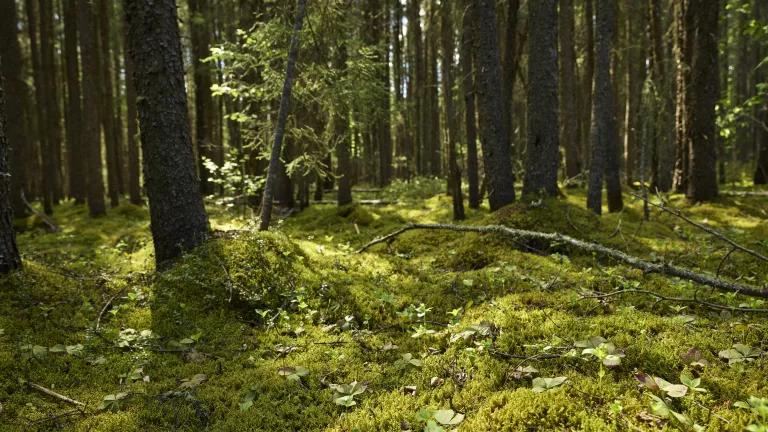How Wolves and Other Wildlife Help Us Fight for the Climate
With all that we’re learning about the critical ways wildlife influence ecosystems and the carbon cycle, it’s all the more important to protect biodiversity.

A gray wolf walks along the edge of a boreal forest in Canada’s Northwest Territories.
This blog is the first in a four-part series that explores the role wildlife plays in boosting ecosystem resilience—and how thriving biodiversity supports our own efforts to mitigate climate change. Read our other blogs on beavers, salmon, and sea otters by clicking the links.
Ecosystems have the power to help us mitigate the worst impacts of climate change—especially when we harness the benefits of “natural climate solutions” (NCS) that restore and protect significant carbon-storing environments like forests, grasslands, and wetlands. But amid the buzz over better stewardship of our planet’s greenery, a growing body of scientific research is unearthing another piece of this complex carbon puzzle: wildlife. This research makes it increasingly clear that biodiversity is not an optional luxury, but integral to the natural life support systems that we all depend upon.
Wild animals play important roles in sculpting ecosystems—with top predators often having the greatest influence, despite their relatively small numbers. This happens because predators, herbivores, plants, and decomposers interact in complex relationships called food webs. We already know that healthy, intact food webs make ecosystems more resilient to environmental changes. Now we’re beginning to understand that because of their influence on plants and soils, the presence and abundance of certain animals within a food web can substantially affect carbon storage. Scientists are demonstrating through innovative research that failure to account for the effects of wildlife on the carbon cycle could result in miscalculating—and misunderstanding—the capacity of ecosystems to take up and store carbon.
One revealing example of this comes from the boreal forest of Canada, which has been identified as one of the most crucial carbon-storing landscapes on earth. While there is widespread recognition that boreal trees and soils store large amounts of carbon, we are only recently starting to understand that wolves and other wildlife in the forest food web are a part of this process too.
As a top predator and keystone species, wolves have an outsize influence on the boreal ecosystem. Moose—as the dominant herbivore—also shape the composition of the forest and the soil microbes because they feed heavily on tree shoots and leaves. Here’s where it gets really interesting: When healthy wolf populations are present in the forest, they directly influence both the foraging behavior and abundance of moose through predation—which changes the way moose interact with boreal plant communities—which alters the forest composition and increases tree biomass—which then enhances carbon storage in both plants and soils.
The result of these interactions is an estimated increase in carbon storage between 46 million and 99 million metric tons attributed to the presence of wolves in the boreal forest compared to the absence of wolves. (That’s equivalent to a year of tailpipe emissions from between 33 and 71 million cars.) When these delicate predator-prey dynamics are left intact, the whole ecosystem benefits from a balanced food web—and so do we.

Researchers are breaking new scientific ground to explore relationships between wildlife and the carbon cycle all over the world. These findings further reinforce the importance of other species to our own future. Other notable links between wildlife, forests, and the carbon cycle include:
- Elephants, rhinos, and other types of mega-herbivores help to spread and germinate the seeds of trees that have particularly high carbon content. Researchers found that without the help of these animal foresters—many of which are threatened by habitat loss and poaching—the carbon storage capacity of certain tropical forest ecosystems could erode.
- On the west coast of North America, sea otters prey on the sea urchins that can decimate coastal marine kelp forests when their numbers aren’t kept in check. Researchers estimate that the presence of otters can enhance kelp biomass carbon storage by 1,100% compared to otter absence in the study area.
- Moving beyond the importance of individual species, researchers have also found that the diversity of mammals within an ecosystem can itself enhance carbon storage. The following short video explains how higher mammal diversity in the Amazon’s tropical forests resulted in higher carbon concentrations in soils.
Unfortunately, top predators face massive threats worldwide, and many other wildlife populations are suffering as a result of exploitation and habitat loss. The loss of species should be alarming in its own right, but these findings suggest additional reasons for concern over the rapid decline of biodiversity in the time of climate change.
If we are to succeed in the fight for a safer and healthier future, we need to forge a new relationship with nature—one where we recognize our deep connections to the diversity of life on earth and step up to defend intact, functioning ecosystems. Governments must take bold action to protect at least 30 percent of our lands, freshwater systems, and oceans by 2030. The growing body of knowledge on the interactions of animals, plants, and carbon is an important reminder not to miss the forest for the trees—and not to take for granted the complex web of life that gives rise to our green, livable planet.



